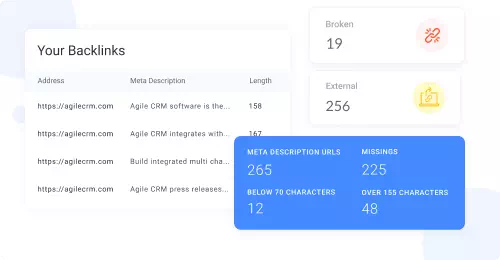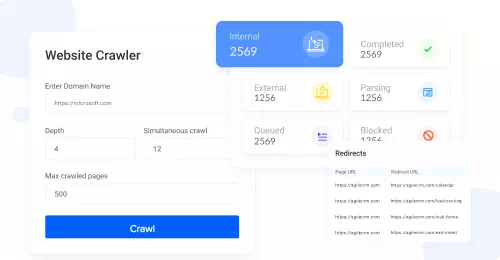What Is Technical SEO?
Technical SEO is a subset of SEO that deals with optimizing your website so search engines understand it. But what does this entail? We'll cover the basics including site structure, load times, and metadata.
#1
Audit, optimize websites, build links and grade webpages
#2
Get a detailed report of backlinks from a frequently updated database of 3.2B inlinks
#3
Generate keywords and LSI based on Google keywords search tool
#4
Generate the site crawl map to get the hierarchical structure of all the web pages and links
#5
Crawl webpages, find score & get recommendations using powerful extension
#6
Identify authors details based on specific keywords & automate outreach activity using links bot
#7
Foster Link Building Proces
#8
Instant Sitemap Generation
#9
Unbelievable pricing - the lowest you will ever find
#10
Everything your business needs - 50 apps, 24/5 support and 99.95% uptime
Page SEO includes all the factors on your site that improve your Search Engine Results Page (SERP). Key SEO factors for pages include backlinks, social media marketing, guest blogging, reputation, and public relations.
Since search engines give priority in search results to websites that have certain technical features (such as secure connections, responsive design, and fast loading times), you must ensure that your website also works. Below is a checklist of the most important steps you can take to ensure that your technical SEO is up to date. Off-page SEO implies a certain dependence on third parties who access websites that agree to host and link to your content.

By following these guidelines you can help ensure that the security and structure of your website meet the expectations of search engine algorithms and are rewarded in search results. We will also cover some items you can add to your checklist, such as a website element audit, to make sure your pages are ready for crawling.
Improve Search Engine Rankings with All-in-One SEO Tool? Sign Up 14 Day Trial
Boost Search Rankings with Technical SEO
Technical SEO refers to the practice of putting improvements to your site to help search engines browse, render and index your site and refers to technical changes that you can make to your site to make it appear in the top results of Google search results. If you want to understand the basic ideas of technical SEO and to create an action plan that saves resources for waste developers and helps you improve site ranking, read on. Now that you know the basics, here are 10 tips you can use to improve your SEO for your websites and boost your search rankings.
Technical SEO is the backend of website optimization that improves page speed, internal linkage, and usability to help web crawlers and web users use and understand your website, leading to higher rankings in organic search results.
Technical SEO practices help search and index pages on your site by Google and other search engines because they ensure that your site is optimized for technical SEO ranking factors. Read on to get started optimizing your site for technical SEO so that your site ranks higher in search results, which leads to more traffic, which can lead to more revenue for your business.
Technical SEO refers to the optimization of website servers, which makes it easier for search engines to search and index content. Technical SEO enables search engines to access your site, making it easier for customers to discover your content. These are a series of web server optimizations that make it easier for crawlers and site visitors to understand and use your website.
Often overlooked by its conspicuous counterpart, Page SEO, the technical side of SEO is no longer so crucial to the success of a website. Using our experience and knowledge in the field of technical SEOs, we can optimize website structures and frameworks from the ground up and deliver huge results based on analyses, recommendations, and ongoing support. A website that is easy to browse and make understandable for search engines is a pillar of technical optimization.
Use Bots to Crawl
In order to perform technical search engine optimization on your website, you must ensure that search bots are able to quickly search, index, and render your content. This means that search engines will be able to categorize your content in the search results and use it as a featured snippet, meaning that more traffic will come to your site. If a search bot is prevented from crawling, it will not index or rank your page.

They can, for example, prevent robots from crawling through certain content they are not supposed to go through. You can also let the robots browse pages, but tell them not to show them in search results and not to follow links to them. If a page that Google cannot find can be searched, the orphaned page will have internal links to searchable pages on your site.
The Common Issues!
As a rule, the more websites you link to, the higher your ranking on Google. The easier it is to find and read your website, the more likely you are to be included in the SERPs. Users are more likely to stay on a website and find what they want because search engines understand that indexing a website is easier.
The biggest mistake many webmasters make in their efforts to optimize their websites for conversion is that they forget about navigation and page structure and end up destroying their SEO.
Many of these creep and indexing problems are the result of too much thinking about the structure of the site. If you build a clear page structure that Google searchers can easily navigate through, you won't have these problems. In addition to specifying what Google sees in screenshots, Google's policies define a structure that helps webmasters determine the points in Google where the most important content on the site is located, which will help drive up the ranking of the pages that matter.
High-quality content that answers search requests offers value and is ripe for backlinks, but it can be difficult to rank well without the right technical SEO in place. A page that is just a few clicks away from the start can cause a number of crawling and indexing problems, particularly when there are few internal links to indicate it. If your website targets more than one country or country where the same language is spoken, search engines may need a little help understanding which country or language you want to reach.
How do Search Engines Work?
Google follows the first index, which means they search and index your site from the perspective of mobile users. Imagine a tab in a catalog library, an index telling you where a website is, where it is and how good its pages are at searching. The stronger are on-page and off-page (technical SEO ranking factors) the better they meet the expectations of search engine algorithms and the higher is the ranking of your websites and websites.
At the time of writing, the crawl stats section can be viewed from the old search console here, which is essential to understand how your site is searched. Pages searched per day, Kilobytes downloaded per day (the time spent downloading a page per millisecond) summarize the creep rate of your websites and their relationship to search engine bots.
Search Engine Optimization (SEO) is the process of understanding search behavior and target audience in order to optimize web content to deliver a relevant experience. Robot.txt is a file that tells search engines like Google which pages to search for and which not.





